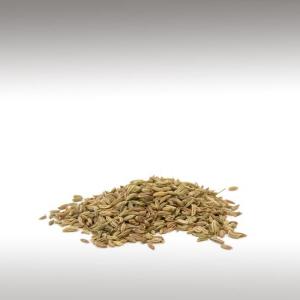
FENNEL ESSENTIAL OIL (FOENICULUM VULGARE) - ESSENTIAL OILS

BASE / GENERAL DATA
Information submited: May 20, 2015 Modified: March 12, 2018 By: OperaDreamhouse
Botanical Name: Foeniculum vulgare
Common Method of Extraction: Steam distilled
Part Typically Used: Seeds
Color: Palle yallow
Consistency: Thin
Perfumery Note: Middle
Strength of Initial Aroma: Sweet, almost peppery, earthy.
Fennel (Foeniculum Vulgare) is a flowering plant species in the celery family Apiaceae or Umbelliferae. It is a hardy, perennial herb with yellow flowers and feathery leaves. It is indigenous to the shores of the Mediterranean but has become widely naturalized in many parts of the world, especially on dry soils near the sea-coast and on riverbanks.
Family is also known as Fenkel and Roman Fennel.
It is a highly aromatic and flavorful herb with culinary and medicinal uses and, along with the similar-tasting anise, is one of the primary ingredients of absinthe.
Fennel, Foeniculum Vulgare, is a perennial herb. It is erect, glaucous green, and grows to heights of up to 2,5 m, with hollow stems. The leaves grow up to 40 cm long. The flowers are produced in terminal compound umbels 5-15 cm wide, each umbel section having 20-50 tiny yellow flowers on short pedicels. The fruit is a dry seed from 4-10 mm long, half as wide or less, and grooved.
The ancient Greeks thought Fennel conveyed long life, courage, and strength. Their name for Fennel was Marathon from Mariano, meaning “To grow thin”. Fennel’s ability to stave off hunger was employed during fasting days in Europe.
Another version: The word "Fennel" developed from the Middle English Fenel or Fenyl. This came from the Old English Fenol or Finol, which in turn came from the Latin Feniculum or Foeniculum, the diminutive of Fenum or Faenum, meaning "Hay".
Fennel oil has a herby, slightly spicy smell, much like Aniseed and it is clear in viscosity.
Chemical structure:
Fennel Aniseed flavour comes from anethole, an aromatic compound also found in Anise and Star Anise, and its taste and aroma are similar to theirs, though usually not as strong.
The main chemical components of Fennel oil are a-pinene, myrcene, fenchone, trans - anethole, methyl chavicol, limonene, 1,8 - cineole and anisic aldehyde.
Fennel seeds are sometimes confused with those of Anise, which are similar in taste and appearance, though smaller.
Fennel is also used as a flavouring in some natural toothpastes.
Common Method of Extraction: Steam distilled
Part Typically Used: Seeds
Color: Palle yallow
Consistency: Thin
Perfumery Note: Middle
Strength of Initial Aroma: Sweet, almost peppery, earthy.
Fennel (Foeniculum Vulgare) is a flowering plant species in the celery family Apiaceae or Umbelliferae. It is a hardy, perennial herb with yellow flowers and feathery leaves. It is indigenous to the shores of the Mediterranean but has become widely naturalized in many parts of the world, especially on dry soils near the sea-coast and on riverbanks.
Family is also known as Fenkel and Roman Fennel.
It is a highly aromatic and flavorful herb with culinary and medicinal uses and, along with the similar-tasting anise, is one of the primary ingredients of absinthe.
Fennel, Foeniculum Vulgare, is a perennial herb. It is erect, glaucous green, and grows to heights of up to 2,5 m, with hollow stems. The leaves grow up to 40 cm long. The flowers are produced in terminal compound umbels 5-15 cm wide, each umbel section having 20-50 tiny yellow flowers on short pedicels. The fruit is a dry seed from 4-10 mm long, half as wide or less, and grooved.
The ancient Greeks thought Fennel conveyed long life, courage, and strength. Their name for Fennel was Marathon from Mariano, meaning “To grow thin”. Fennel’s ability to stave off hunger was employed during fasting days in Europe.
Another version: The word "Fennel" developed from the Middle English Fenel or Fenyl. This came from the Old English Fenol or Finol, which in turn came from the Latin Feniculum or Foeniculum, the diminutive of Fenum or Faenum, meaning "Hay".
Fennel oil has a herby, slightly spicy smell, much like Aniseed and it is clear in viscosity.
Chemical structure:
Fennel Aniseed flavour comes from anethole, an aromatic compound also found in Anise and Star Anise, and its taste and aroma are similar to theirs, though usually not as strong.
The main chemical components of Fennel oil are a-pinene, myrcene, fenchone, trans - anethole, methyl chavicol, limonene, 1,8 - cineole and anisic aldehyde.
Fennel seeds are sometimes confused with those of Anise, which are similar in taste and appearance, though smaller.
Fennel is also used as a flavouring in some natural toothpastes.

SPIRITUAL PRACTISES DATA

MEDICINE / HEALTH DATA

BEAUTY / COSMETICS DATA

FOOD / COOKING DATA
Information submited: March 12, 2018 By: OperaDreamhouse
Theseeds are used incookery and sweet desserts.
Fennel is one of the three main herbs used in the preparation of absinthe, an alcoholic mixturewhich originated as a Medicinal elixir in Switzerland and became, by the late 19th century, a popular alcoholic drink in France and other countries.
Many cultures in India, Pakistan, Afghanistan, Iran, and the Middle East use Fennel seed in their cookery. It is one of the most important spices in Kashmiri Pandit and Gujarati cooking.
Fennel seeds are the primary flavor component in Italian sausage.
Many egg, fish, and other dishes employ fresh or dried Fennel leaves. Florence Fennel is a key ingredient in some Italian and German salads, often tossed with chicory and avocado, or it can be braised and served as a warm side dish. It may be blanched or marinated, or cooked in risotto.
Fennel is one of the three main herbs used in the preparation of absinthe, an alcoholic mixturewhich originated as a Medicinal elixir in Switzerland and became, by the late 19th century, a popular alcoholic drink in France and other countries.
Many cultures in India, Pakistan, Afghanistan, Iran, and the Middle East use Fennel seed in their cookery. It is one of the most important spices in Kashmiri Pandit and Gujarati cooking.
Fennel seeds are the primary flavor component in Italian sausage.
Many egg, fish, and other dishes employ fresh or dried Fennel leaves. Florence Fennel is a key ingredient in some Italian and German salads, often tossed with chicory and avocado, or it can be braised and served as a warm side dish. It may be blanched or marinated, or cooked in risotto.
COMMENTS
No comments.


